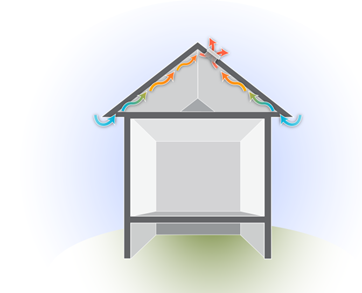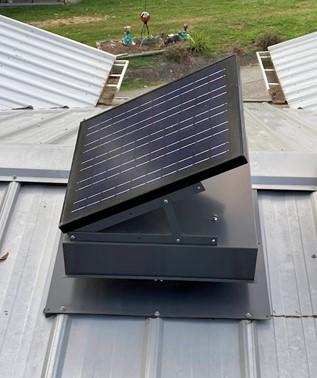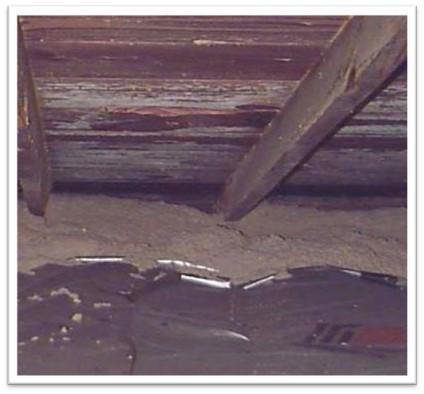Attic ventilation fans (also called “powered attic ventilators” or simply “attic fans”) are exhaust fans located in the roof or gable wall of the attic. They pull outside air into the attic through intake vents located in the soffits, eaves, or gables. The air inside the attic is exhausted through the fan to the outside (Figure 1).
Attic ventilation fans can be powered by the home’s electrical system, or they can be stand-alone solar-powered devices (Figure 2). Hybrid units are also available that rely on the home’s electrical system as a backup to solar power. Attic fans can be controlled as on or off, on a timeclock schedule, or they can be set to operate only when the sun is shining (solar powered units do this by default). Operation can also be based on temperature and/or humidity level in the attic.
Note that attic ventilation fans are different from whole-house fans, which pull air through the house and exhaust it into the attic, where it escapes through attic vents. Whole-house fans are designed to exhaust and cool the living space, while attic ventilation fans are designed to exhaust and cool the unconditioned attic space. Whole-house fans are sometimes referred to as “attic fans,” causing confusion between the two technologies. See the Whole-House Fans guide for more information on whole-house fans.
Ventilating unconditioned attics serves three primary purposes:
- To save energy by exhausting heat from the attic in summer
- To prevent mold and rot by exhausting moisture from the attic in the winter
- To prevent water damage from ice dams by keeping the roof cooler in the winter
All these purposes can be achieved using either attic ventilation fans or passive attic ventilation systems. Passive attic ventilation is achieved without fans through an arrangement of vents in the soffits, eaves, gables, and/or ridge of the roof structure. Attic air is exhausted naturally via the stack effect and wind effects. The following BASC guides provide detailed information on passive attic ventilation techniques, applications, and installation methods: Vented vs Unvented Attic; Calculating Attic Passive Ventilation; Condensation Control in Attics and Roofs in Cold Weather; Attic Air Sealing, Insulating, and Ventilating for Ice Dam Prevention; Construct Roofs and Attics for Ice Dam Prevention; Roof Vents.
Attic ventilation fans typically exhaust more heat from the attic than passive attic ventilation systems and can potentially provide a greater reduction of a home’s cooling loads. The incremental benefit is usually not large, however, and can be counteracted by the negative effects of attic fans as described below. Passive attic ventilation is generally recommended over attic ventilation fans due to the multiple issues that can arise with the use of attic fans.
Concerns with Attic Ventilation Fans
Attic ventilation fans can be used to increase attic ventilation beyond what is provided by passive vents. They can also be used as a retrofit to provide ventilation where passive attic ventilation was not installed originally. These fans are often touted as a simple retrofit to save energy in the summer. There is no doubt that attic ventilation fans remove heat from the attic. However, the cooling effect on the living space below the attic is usually much less than might be expected. Most of the heat transfer from the roof to the attic floor is radiant rather than convective, greatly reducing the effect attic fans can have on overall heat transfer. Studies generally show that these fans can decrease a home’s cooling load by small to moderate amounts (FSEC 2000). Their effect is greatest when there is little insulation in the attic, the roof has low solar reflectivity, the roof is poorly shaded, the attic has no radiant barrier, and/or when HVAC equipment is located in the attic. Studies also indicate that attic ventilation fans often cause more overall energy loss than they save and can actually increase moisture issues in winter (Figure 3) (FSEC 2005, CMHC 1999, DOE 2012).
The primary reason that attic fans can increase energy consumption and moisture issues is that they create a negative pressure zone inside the attic. This negative pressure draws conditioned air from the living space into the attic through gaps in the ceiling. Properly designed passive attic ventilation, on the other hand, will create far less negative pressure due to the weaker airflow forces and the even balance of intake and exhaust vent area. The increased negative pressure caused by attic ventilation fans can cause the following issues:
- In summer, conditioned air is pulled out of the house, and hot, moist outside air is drawn into the building assembly and the living area. This can result in:
- Increased air conditioning (A/C) energy consumption
- Mold growth inside walls and insulated floors
- Mold growth in crawl spaces.
- In winter, warm, moist air is pulled from the house to the attic, and cold outside air is drawn into the living area. This can result in:
- Increased heating energy consumption
- Mold and moisture damage in the attic.
- Unhealthy air from garages and crawl spaces can be pulled into the living space.
- Radon gas can be pulled into basements and crawl spaces.
- Combustion appliances (other than sealed combustion) may not draft as well or could potentially backdraft.
- Bathroom and kitchen exhaust fans may not be as effective (the attic fan is working against them), making moisture issues in the house and the attic worse in both summer and winter.
Other issues with attic ventilation fans include the following:
- Studies have shown that they can use more electricity for powering the fan than they save in A/C consumption (FSEC 2005).
- In hot-humid climates, condensation and moisture issues can occur on poorly insulated and sealed A/C ductwork or air handling units located in the attic (this can occur with passive ventilation as well, but could be exacerbated by attic ventilation fans) (BSC 1998)
- House fires can be made worse by increasing airflow to the flames.
- Embers from wildfires can be sucked into the attic.
Many of these risks can be greatly reduced by thoroughly air sealing the ceiling, ensuring ample intake vent area is provided, using a fan with a low flow rate, using a solar-powered fan, and other measures. However, many building scientists consider the risks of attic ventilation fans to be greater than the advantages, and do not recommend using them. They are not recommended by the ENERGY STAR program (ENERGY STAR 2022), and they are not allowed by the Georgia State Energy Code (unless solar powered) (GDCA 2020).
Why are Attic Ventilation Fans Installed, and What Could be Done Instead?
Attic ventilation fans are usually installed in response to very hot attics, moisture issues in attics, or ice dams. Rather than install an attic ventilation fan to try to address these issues, the following best practices are recommended.
Attic is Too Hot: Attic ventilation fans are often installed in an attempt to save energy by cooling the attic and reducing the heat transferred from the attic to the living area. This has proven to be mildly effective when compared to passive ventilation in most instances. Reducing the attic temperature has a relatively small effect on the home’s cooling load if the ceiling is well-insulated. Instead of installing an attic fan, best practice recommendations include:
- Increase insulation levels in the attic and air seal the ceiling deck.
- Increase air sealing and insulation of any HVAC equipment and ductwork located in the attic. Ideally this equipment would be located elsewhere, within the building’s thermal envelope.
- Improve passive ventilation by clearing air flow obstructions (such as insulation at the eaves) and/or with additional well-placed vents.
- Consider installing a radiant barrier on the underside of the roof and/or replacing the roofing material with Cool Roof-certified roofing.
Moisture Issues in the Attic: Attic ventilation fans are often installed in an attempt to remove moisture and prevent condensation in the attic in the winter. This has proven to be ineffective and even detrimental in many cases (Woods 2000). Instead of installing an attic fan, best practice recommendations include the following:
- Thoroughly air seal at the ceiling between the attic and the living area.
- Ensure bathroom and kitchen exhaust fans are operational and vented to the outside (not to the attic).
- Ensure there is adequate passive ventilation. Ensure that there is not more exhaust vent area (high vents) than intake vent area (low vents), as this can increase negative pressure in the attic. For example, ridge vents are typically exhaust vents while soffit vents are usually intake vents in a passive system. Note that increasing passive attic ventilation can make moisture issues worse if the ceiling below the attic is not thoroughly air sealed first.
- Increase air sealing of HVAC ducting and AHUs located in the attic. If possible, do not locate HVAC ducting or AHUs in an unconditioned attic. This can cause pressure differences which may introduce warm, moist air into the attic.
Ice Dams: Attic ventilation fans are often installed in an attempt to prevent ice dams in the winter. Instead of installing an attic fan, best practice recommendations include the following:
- Thoroughly air seal at the ceiling between the attic and the living area
- Increase insulation levels in the attic
- Ensure bathroom and kitchen exhaust fans vent to the outside (not to the attic)
- Ensure there is adequate passive attic ventilation.
- Increase air sealing and insulation of HVAC ducting and AHUs located in the attic. If possible, do not locate HVAC ducting or AHUs in the unconditioned attic.
What to do if an Attic Ventilation Fan will be Installed
If a homeowner or contractor decides that the benefits of an attic ventilation fan outweigh the risks, the following steps will mitigate potential issues and improve performance:
- Thoroughly air seal the ceiling to prevent the attic fan from pulling air out of the conditioned space.
- Ensure ample intake vent area to reduce the amount of air pulled from the conditioned space.
- Use a lower CFM fan to create less negative pressure. Target 50 CFM of attic ventilation per 1,000 ft2 of attic floor area. This exhaust rate has been shown to adequately control vapor in attic assemblies and is required for some unvented assemblies by the IRC 2021.
- Use a solar-powered unit to eliminate electricity cost and to operate only when the sun is shining. This ensures the unit does not pull in night air (which has higher relative humidity) and does not operate when it is raining (preventing intrusion of rain and high humidity air). Solar-powered fans also tend to have lower CFM ratings, creating less negative pressure.
- Air seal between the living area and the garage, crawl space, and other attached and unconditioned spaces.
- Install radon mitigation to reduce the likelihood of radon being pulled into the living space.
- Ensure there is no combustion equipment in the attic (negative pressures induced by the attic fan can backdraft combustion systems).
- Use intake vents with ≤1/8- inch metal screens to prevent intrusion of wildfire embers.
- Ensure bathroom and kitchen exhaust fans are operable and properly vented directly to the outside.
- Consider only operating the fan in the summer if its primary purpose is to reduce cooling load.
- Locate the fan high in the attic and most of the intake vents low in the attic (ideally at the soffits/eaves). Locate the fan and intakes far from one another such that intake air will flow across all areas of the attic. Distribute intakes around the attic perimeter so that areas such as wings, dormers, and other nooks receive ventilation air.
More Info
The following authors and organizations contributed to the content in this Guide.


